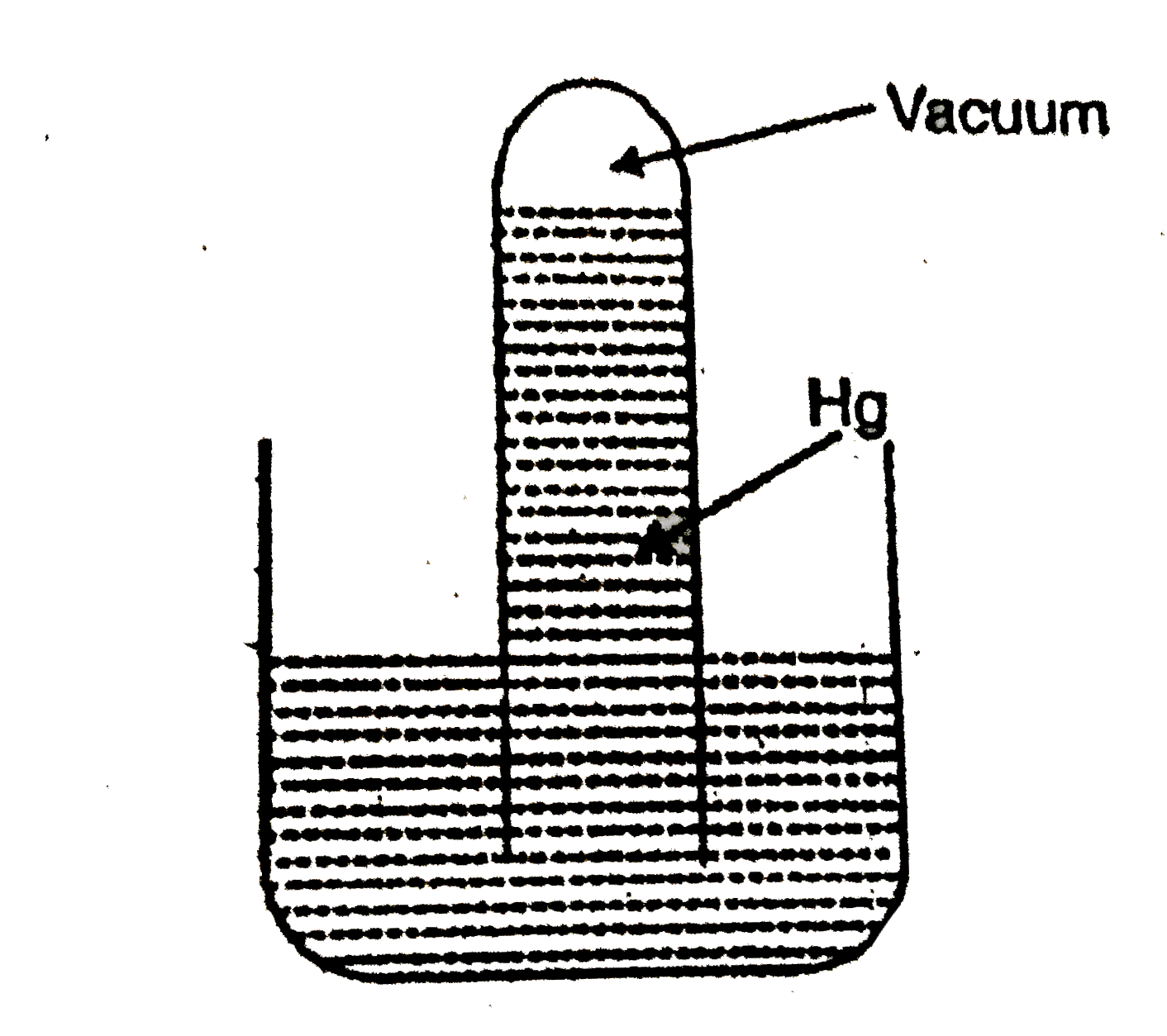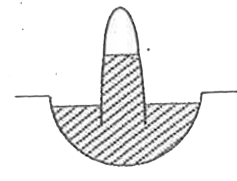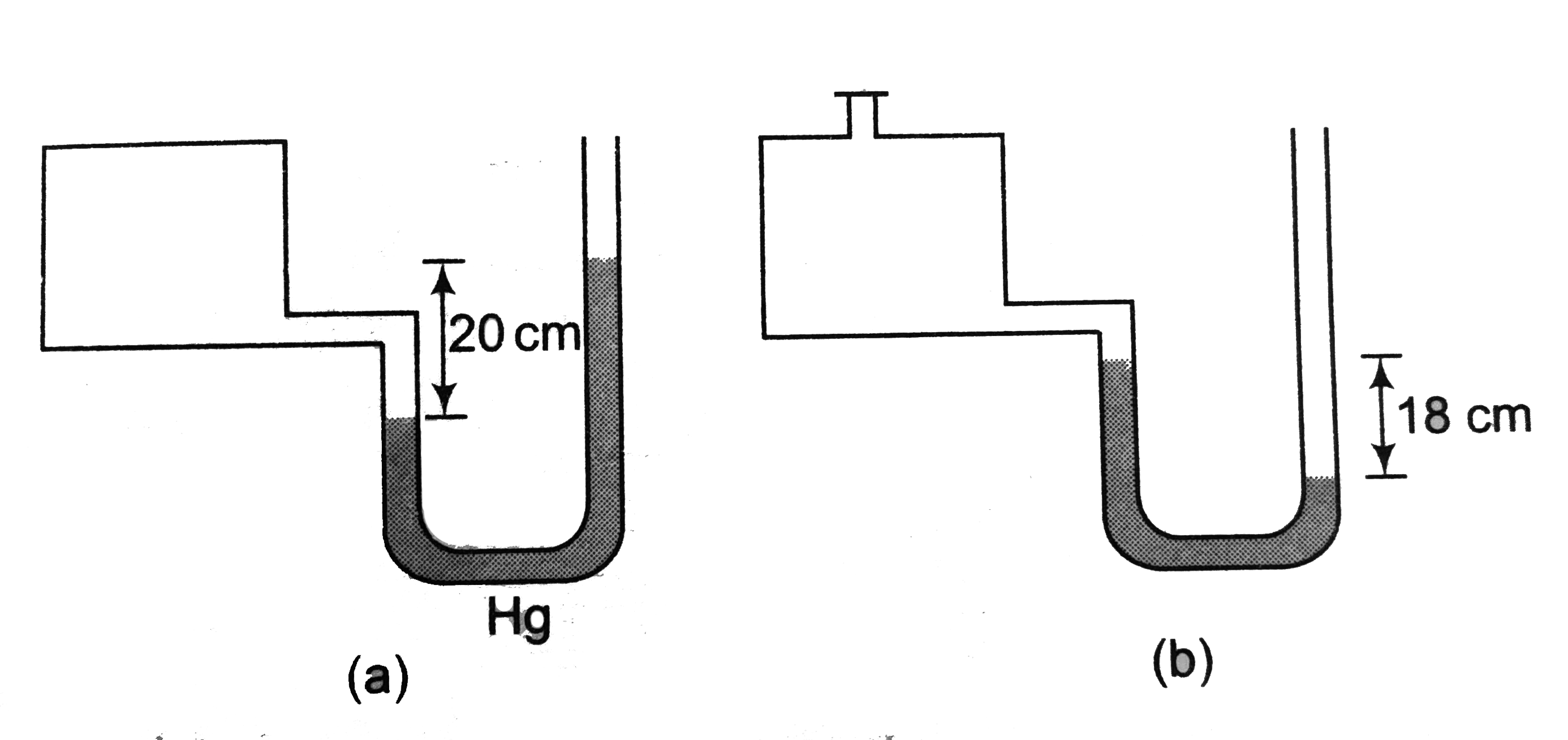A glass bulb is connected to an open-limb manometer. The level of mercury on both limbs was same. The bulb was heated to 57∘C. If the room temperature and atmospheric pressure are 27∘C and 750 mmHg, the difference of levels in the two limbs now will be
2.5 cm
5cm
7.5 cm
10 cm
The correct Answer is:C
To solve the problem, we will use the relationship between pressure and temperature given by Gay-Lussac's law, which states that the pressure of a gas is directly proportional to its absolute temperature when the volume is held constant.
1. Identify Given Data:
- Initial atmospheric pressure (P1) = 750 mmHg
- Initial temperature (T1) = 27°C
- Final temperature (T2) = 57°C
2. Convert Temperatures to Kelvin:
- To convert Celsius to Kelvin, use the formula:
K=°C+273
- For T1:
T1=27+273=300K
- For T2:
T2=57+273=330K
3. Use Gay-Lussac's Law:
- According to Gay-Lussac's law:
P1T1=P2T2
- Rearranging to find P2:
P2=P1×T2T1
4. Substitute Values:
- Substitute the known values into the equation:
P2=750mmHg×330K300K
5. Calculate P2:
- Performing the calculation:
P2=750×1.1=825mmHg
6. Find the Difference in Pressure:
- The difference in pressure between the two limbs of the manometer is:
Difference=P2−P1=825mmHg−750mmHg=75mmHg
7. Final Answer:
- The difference in the levels of mercury in the two limbs of the manometer is:
Difference=75mmHgor7.5cm
- Initial atmospheric pressure (P1) = 750 mmHg
- Initial temperature (T1) = 27°C
- Final temperature (T2) = 57°C
- To convert Celsius to Kelvin, use the formula:
K=°C+273
- For T1:
T1=27+273=300K
- For T2:
T2=57+273=330K
- According to Gay-Lussac's law:
P1T1=P2T2
- Rearranging to find P2:
P2=P1×T2T1
- Substitute the known values into the equation:
P2=750mmHg×330K300K
- Performing the calculation:
P2=750×1.1=825mmHg
- The difference in pressure between the two limbs of the manometer is:
Difference=P2−P1=825mmHg−750mmHg=75mmHg
- The difference in the levels of mercury in the two limbs of the manometer is:
Difference=75mmHgor7.5cm
Topper's Solved these Questions
- STATES OF MATTERBOOK - VMC MODULES ENGLISHCHAPTER - STATES OF MATTEREXERCISE - IMPECCABLE
50 Videos
- STATES OF MATTERBOOK - VMC MODULES ENGLISHCHAPTER - STATES OF MATTEREXERCISE - ENABLE
50 Videos
- SOME BASIC CONCEPTS OF CHEMISTRYBOOK - VMC MODULES ENGLISHCHAPTER - SOME BASIC CONCEPTS OF CHEMISTRYEXERCISE - IN - CHAPTER EXERCISE - H
8 Videos
- STATES OF MATTERBOOK - VMC MODULES ENGLISHCHAPTER - STATES OF MATTEREXERCISE - IN-CHAPTER EXERCISE-I
10 Videos
Similar Questions
A gas is filled into a bulb connected to an open limb manometer. The level of mercury in the open arm is 2.1 cm lower than that in the other arm of the manometer. The atmospheric pressure is 740 mm. What is the pressure of the gas?
View SolutionA glass bulb of volume 400cm3 is connected to another bulb of volume 200cm3 by means of a tube of negligible volume. The bulbs contain dry air and are both at a common temperature and pressure of 20∘C and 1.000 atm, respectively. The larger bulb is immersed in steam at 100∘C and the smaller in melting ice at 0∘. Find the final common pressure.
View Solution
Knowledge Check
Which one of the following substances has highest specific heat capacity at room temperature and atmospheric pressure ? a) Water b) Ice c) Aluminum d) Mercury
AWaterBIceCAluminiumDMercury
The difference in the heights of mercury levels in an open end manometer connected to a gas chamber is found to be 175 mm. If the height of mercury level in the smaller limb is more as compared to that in the longer limb and the atmospheric pressure is 755 mm, what is the pressure of the gas ?
View SolutionIn a constant volume gas thermometer, the pressure of the working gas is measured by the difference in the levels of mercury in the two arms of a U-tube connected to the gas at one end. When the bulb is placed at the room temperature 27.00C, the mercury column in the arm open to atmosphere stands 5.00cm above the level of mercury in the other arm. When the bulb is placed in a hot liquid, the difference of mercury levels becomes 45.0cm. Calculate the temperature of the liquid. (Atmospheric pressure =75.0cm of mercury).
View SolutionIn a constant volume gas thermometer, the pressure of the working gas is measured by the differenced in the levels of mercury in the two arms of a U-tube connected to the gas at one end. When the bulb is placed at the room temperature 27.00C, the mercury column in the arm open to atmosphere stands 5.00cm above the level of mercury in the other arm. When the bulb is placed in a hot liquid, the difference of mercury levels becomes 45..0Cm. Calculate the temperature of the liquid. (Atmospheric pressure =75.0cm of mercury).
View SolutionThe arms of a U shaped tube are vertical. The arm on right side is closed and other arm is closed by light movable piston. There is mercury in the tube and initially the level of the mercury in the arms is the same. Above the mercury, there is an air column of height h in each arm, and initial pressure is the same as atmospheric pressure in both arms. Now pistion is slowly pushed down by a distance of h/2 (see figure)

Let x is the displacement of mercury level in one of the stem and P1 is pressure in left column of air after compression, P2 is pressure in right column of air after compression and P0 is atmospheric pressure then
View SolutionState true/false:
S1 : Hydrostatic pressure is a scalar quantity even though pressure is force divided by area and force is a vector quantity?
S2: A barometer made of a very narrow tube (see figure) is placed at normal temperature and pressure. The coefficient of volume expansion of mercury is 0.00018/.∘C and that of the tube is negligible. The temperature of mercury in the barometer is now raised by 1∘C but the temperature of the atmosphere does not change. Then, the mercury height in the tube remains unchanged.
S3 A block of ice with a lead shot embedded in it is floating on water contained in a vessel. The temperature of the system is maintained at 0∘C as the ice melts. When the ice melts completely the level of water in the vessel rises.

View SolutionTorricelli was the first do devise an experiment for measuring atmospheric pressure . He took calibrated hard glass tube , 1 m in lengt and of uniform cross section , closed at one end . He filled the whole tube with dry mercury taking care than no air or water droplets remain inside the tube , closed the opposite end of the tube tightly with thumb and inverted it . He put this inverted mercury tube into a mercury through , taking care that the end of the tube remains inside the mercury through , An interesting thing was noticed . Mercury in the tube fell down at first and then stopped at a particular position . The height was 76 cm above the free surface of mercury in the through . When the given tube was inclined or lowered in the mercury trough , the vertical haight of mercury level in the tube was always found constant .
Torricelli explained this by saying that the free surface of mercury in the trough . Hence , the hydrostatic pressure exerted by the trough measures the atmospheric pressure .

If this expriment uses water instead of mercury , then
A. length of water will be equal to 76 cm
B. length of water will be less than 76 cm
C. length of water will be greater than 76 cm
D. none of the above
View SolutionA manometer reads the pressure of a gas in a enclosure as shown in figure(a) When some of the gas is removed by a pump, the manometer reads as in (b). The liquid used in the manometers is mercury and the atmospheric pressure is 76cm of mercury.

(i) Give the absolute and gauge pressure of the gas in the enclosure for cases (a) and (b) in units of cm of mercury .
(ii) How would the level change in case (b) if 13.6cm of water are poured into the right limb of the manometer?
View Solution
